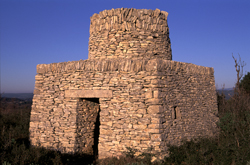Souvignargues
|
Souvignargues Sauvinhargues |
||
|---|---|---|

|
|
|
| region | Occitania | |
| Department | Gard | |
| Arrondissement | Nîmes | |
| Canton | Calvisson | |
| Community association | Pays de Sommieres | |
| Coordinates | 43 ° 49 ′ N , 4 ° 7 ′ E | |
| height | 42-173 m | |
| surface | 11.09 km 2 | |
| Residents | 871 (January 1, 2017) | |
| Population density | 79 inhabitants / km 2 | |
| Post Code | 30250 | |
| INSEE code | 30324 | |
| Website | http://mairie-lacalmette.com/ | |
 Souvignargues - Cabane Le Malet |
||
Souvignargues ( Occitan : Sauvinhargues ) is a place and a municipality in the south of France with 871 inhabitants (as of January 1, 2017) in the Gard department in the Occitanie region . The village of Escattes also belongs to the municipality .
location
The round village ( Circulade ) Souvignargues is located at an altitude of about 100 meters above sea level. d. M. about 25 kilometers (driving distance) west of Nîmes near the border to the Hérault department .
Population development
| year | 1968 | 1975 | 1982 | 1990 | 1999 | 2006 |
| Residents | 406 | 370 | 460 | 545 | 589 | 683 |
In the 19th century, the place usually had over 600 inhabitants. As a result of the phylloxera crisis in viticulture and the increasing mechanization of agriculture , the number of inhabitants has since fallen to the lows since the 1920s. Due to the relative proximity to the city of Nîmes and the significantly lower property prices in the countryside, there has been a significant increase in the population in recent years.
economy
In earlier times, the residents of the village lived largely on self-sufficiency from agriculture, with both grain and wine being grown. In addition, they ran a little cattle (pigs, chickens, etc.). As in many places in Languedoc , viticulture has dominated since the 19th century; the regional wine cooperative markets the wine produced here through the appellations of Gard , Languedoc and Pays d'Oc . Because of the sales crisis for French wine, however, viticulture is only practiced on a few areas; predominantly grain ( wheat , maize ) and sunflowers are grown again.
history
As the two Romanesque churches show, the villages of Sauvignargues and Escattes already existed in the 12th century. The round town center of Sauvignargues suggests that the town moved to the shelter of a castle ( château ) that has only survived in ruins . During the Huguenot Wars (1562–1598) the churches in both places were destroyed or damaged. The Church of Escattes was attacked again in the Camisard Wars (1703). Both places were merged into one community shortly after the outbreak of the French Revolution .
Attractions
- Souvignargues
- The old town center of Souvignargues belongs to the type of circulades - round villages that were built around a core consisting of a castle and / or church for defense reasons and whose outer house front served as a replacement for an expensive city wall.
- The ruins of the Saint-André church, built in the 12th century, are located about 600 meters northeast of Souvignargues. It was a single nave building with a semicircular apse . Due to some stones with decorative motifs ( capitals , friezes, etc.), the church was recognized as a monument historique in 1949 .
- The new parish church is a 16th century building; however, it was fundamentally renewed in the 19th century.
- The Protestant church ( temple ) dates from the 19th century.
- Escattes
- The simple Romanesque church of Saint-Étienne is located in the village of Escattes , about three kilometers to the east . It was damaged in the course of the Huguenot Wars of the 16th century, but was preserved as a whole; the portal and the bell gable ( clocher mur ) were renewed during this time. The church has been recognized as a monument historique since 1949 . Above the central window of the otherwise unadorned outer wall of the apse there are two Latin inscriptions carved in stone , which probably come from other buildings and were reused here as spoils :
- Surroundings
- In the municipality there are several field stone huts ( cabanes ) made of dry stone , mostly built in the 19th century , in which guards stayed at the time of the grape harvest to keep flocks of birds, wild boars or thieves away. The most impressive is the two-story Cabane Le Malet .
Web links
- Souvignargues, Cabane Le Malet - Photos + information (French)
- Souvignargues and Villevieille, Cabanes - photos + information (French)
- Souvignargues, wine information (French)
Individual evidence
- ↑ Église Saint-André, Souvignargues in the Base Mérimée of the French Ministry of Culture (French)
- ↑ Église Saint-Étienne d'Escattes, Souvignargues in the Base Mérimée of the French Ministry of Culture (French)


